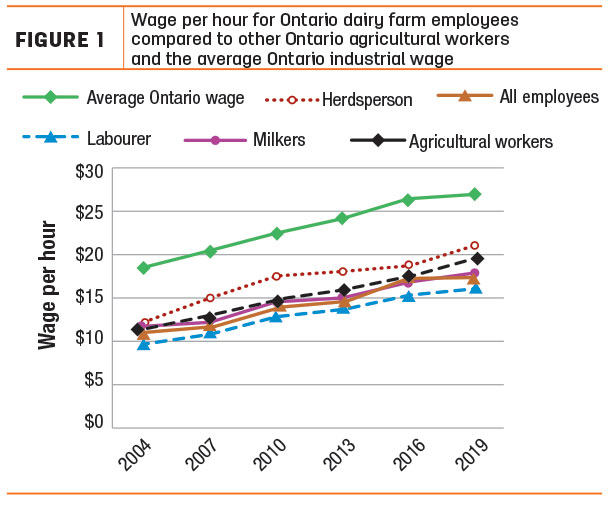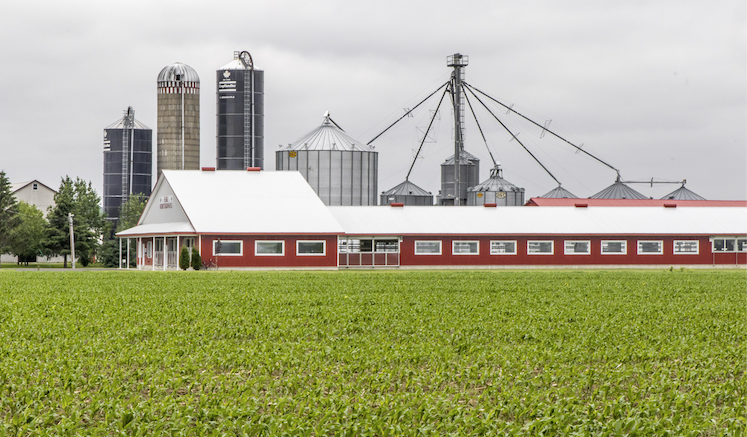The following article summarizes dairy farm labour data for non-related employees from a recent survey by Progressive Dairy Operators (PDO) including hours worked, wages and benefits.
The PDO Labour Survey, completed in January 2019, focused on labour needs of dairy operations located in Ontario who are PDO members. The survey received 117 responses with an average herd size of 157 milking cows. Most of the respondents used parallel milking parlours (39%), followed by robotic milking (32%).
The survey analyzed data from 305 non-related employees for wage, hours worked per week and benefits received. Labour turnover on dairy farms was high. A majority of the non-related employees were in the same position for less than four years. Many calf feeders and milkers were in their respective positions for less than one year. This suggests a high turnover of employees in task-specific jobs, which were also the most frequently employed positions on the farm. This is in contrast with herdworkers (an employee assigned to multiple tasks on the farm, such as feeding, milking, etc.) and herdspersons (an employee placed in a management role), who were more likely to be employed for longer than five years on the farm.
Many of the non-related employees on the farm were between 15 and 32 years old (52%). Female employees made up 32% of the reported non-related employees on dairy farms, which increased by 8% from the previous labour survey in 2016.
Hours worked per week
Non-related employees worked an average of 26.4 hours per week, representing both full-time and part-time employees. The average hours worked per week varied based on the position. Calf feeders, milkers and labourers worked on average 20 hours per week and would be considered part-time positions. Full-time positions on the farm included herdworkers (32.5 hours), herdspersons (41.6 hours), managers (33.3 hours) and feeders (34.6 hours).
The number of hours worked by non-related employees for each job position on the farm varied. The variation in hours worked per position was related to the size of the operation and the number of workers that were family members working on the farm. When advertising hours of work for a job, be clear on how many hours the employee will be expected to work and outline your expectations and policies around overtime.
Wage and benefits
Compensation for hours worked by an employee is an important aspect of recruitment and retaining of employees. The average hourly wage paid to non-related employees on dairy farms in Ontario was $17.95 per hour. On average, all positions were paid above the current minimum wage rate in Ontario, which was $14 per hour as of January 2018.
Hourly wages varied by job function. Decision-making roles on the farm, such as managers and herdspersons, were paid more on an hourly basis (average of $21.36 per hour) than task-oriented positions such as calf feeders, milkers, labourers and herdworkers (average of $15.82 per hour).
Hourly wage rates continue to increase in Ontario. Statistics Canada reported an increase of 0.5% to 1% per year in hourly wage paid to employees classified as industrial workers from 2004 to 2019 across Ontario. Hourly wages paid on dairy farms in this study was similar to other reported agricultural workers in Ontario. Average hourly wages paid to non-related employees on the participating dairy farms was lower than Ontario industrial employees but showed the same trend of 0.5% to 1% increase in wages from 2004-19 shown in Figure 1.

When considering wages for hired labour, employers in the dairy industry will have to set competitive rates in order to continue to attract and retain skilled employees. To determine a competitive wage for your region, look at what other businesses pay per hour and the average cost of living. One should also consider employee benefits and a strong workplace culture in their compensation structure.
Forty-three percent of all non-related employees received a non-monetary benefit as a part of their compensation. Top benefits received by non-related employees included paid time off or vacation pay, housing, health and dental benefits, and meat and/or milk for consumption. Decision-making positions such as managers (67%) and herdspersons (84%) were more likely to receive benefits than task-oriented positions such as calf feeder (35%), herdworker (37%), milker (35%), labourer (44%) and feeder (57%). Other benefits offered could include an education fund for your employees that allows them to further develop and hone their skills or special recognition days for work accomplished.
Hiring new employees
The average number of full-time and part-time employees or positions on a farm was 5.4. There is a need to hire new employees on an ongoing basis with the high rate of turnover reported on dairy farms. Labour shortages and limited access to skilled labour is an issue in agriculture and presents a challenge in an industry where there is a high turnover of employees, as the pool of potential candidates is small and competitive.
Participants in the survey were asked, “What are some of the biggest challenges you face when recruiting new employees?” For those participants who reported hiring or have hired employees, the number one challenge with finding new employees was “that applicants lack the motivation and desire to do the kind of work that is being offered” (31%). The second challenge was that the “hours offered do not suit applicants’ expectations” (19%), followed closely by “applicants that applied to the job lacked the necessary skills for the job” (18%).
Those planning to hire in the dairy industry will have to think creatively about how to attract and retain new employees. Consider offering cross training opportunities on the farm, flexible work hours and a strong training program for new employees.
Workplace culture
Compensation (wage and benefits) is only one part of hiring and managing employees. Creating a strong workplace culture will take effort as a manager. At the end of the day, employees want clear expectations, recognition of the work done, a manager who will follow through and a safe workplace where they know it will be free of harassment. As a manager, spending the time to build relationships with employees will create a positive space that will facilitate sharing of issues before they become problems and allowing employees to suggest ways to improve their work to make it more efficient or safer. ![]()
PHOTO: Photo by Mike Dixon.
Marlene Paibomesai is a dairy specialist with the Ontario Ministry of Agriculture, Food and Rural Affairs (OMAFRA) and serves as an adviser to the Progressive Dairy Operators (PDO) board of directors.








